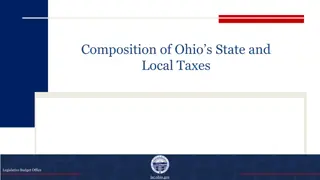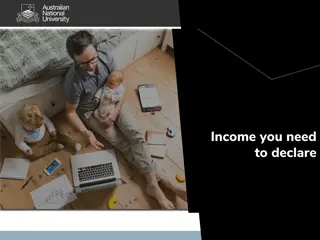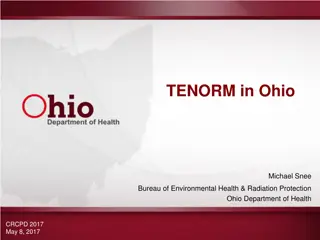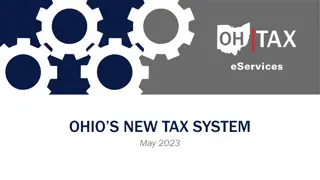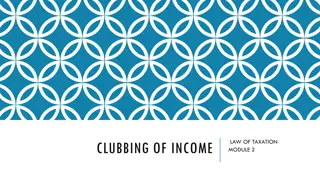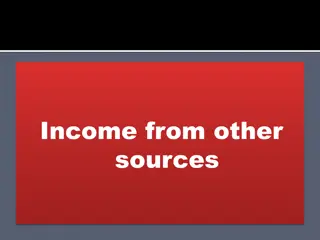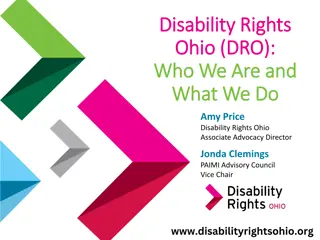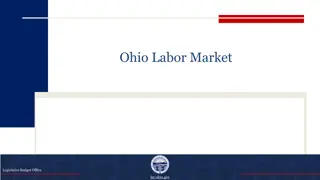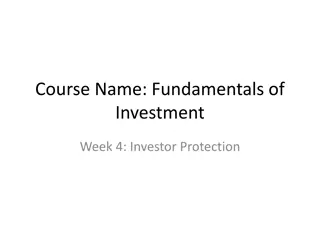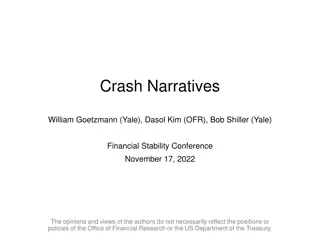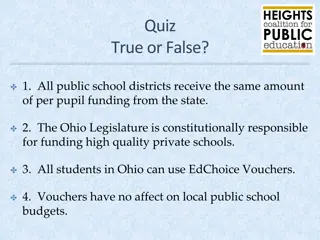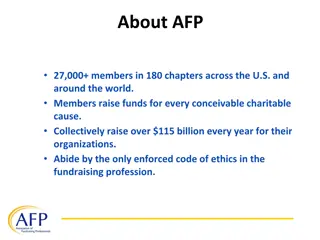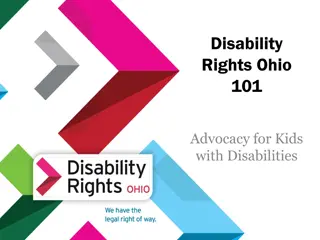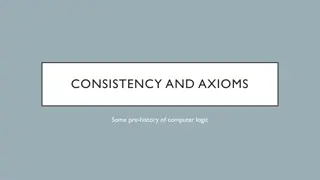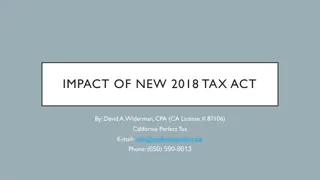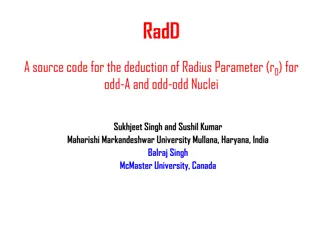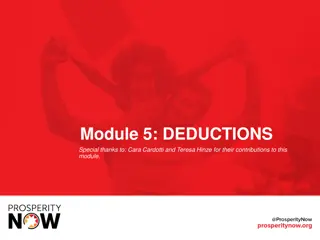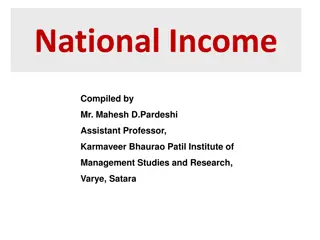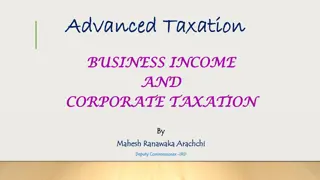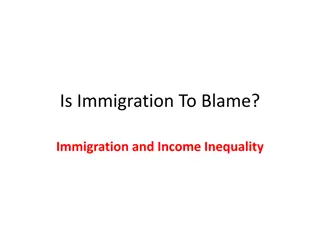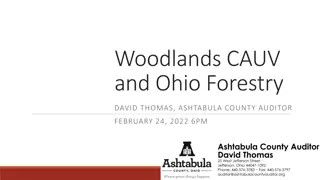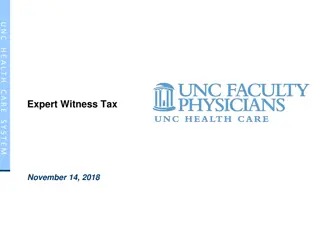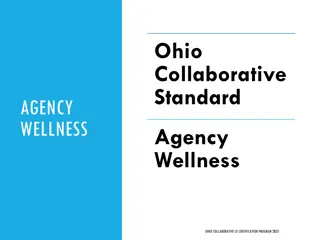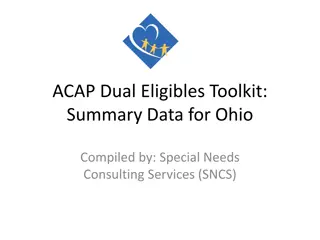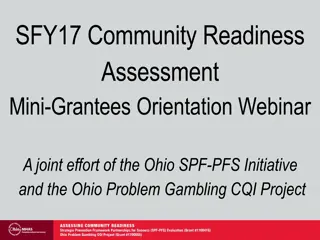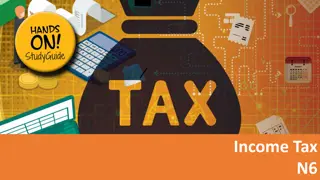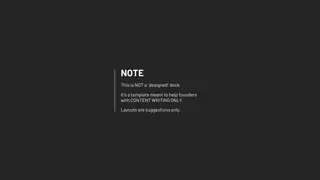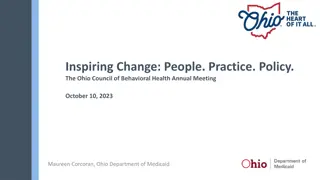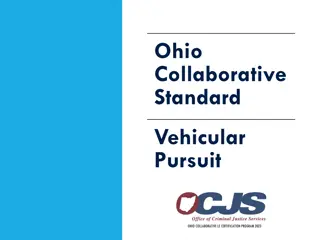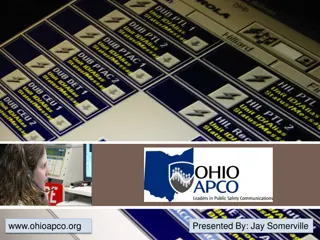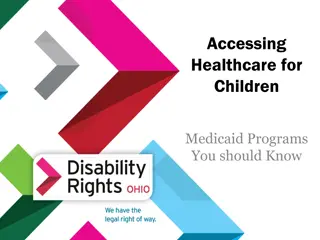Ohio Small Business Investor Income Deduction Overview
Ohio offers a 50% Small Business Investor Income Deduction for individuals, allowing up to $250,000 of small business investor income to be deducted at 50% for taxable years 2013 and beyond. This deduction is reported on Schedule IT SBD and Form IT1040 Schedule A. The deduction is favorable for business owners who did not benefit from the elimination of the Corporation Franchise Tax in Ohio. FAQ and instructions are available at www.tax.ohio.gov.
Download Presentation

Please find below an Image/Link to download the presentation.
The content on the website is provided AS IS for your information and personal use only. It may not be sold, licensed, or shared on other websites without obtaining consent from the author. Download presentation by click this link. If you encounter any issues during the download, it is possible that the publisher has removed the file from their server.
E N D
Presentation Transcript
OHIO 50% SMALL BUSINESS INVESTOR INCOME DEDUCTION Deborah Smith, Administrator Raina Nahra, Division Counsel
50% Small Business Deduction New 50% Small Business Investor Income Deduction Effective taxable year 2013 and forward Amounts to 50% of OH small business investor income of up to $250,000. Taken only by individuals on IT1040 Schedule A Can t exceed $62,500 for each spouse filing separately or $125,000 for all other taxpayers Favorable to business owners who did not benefit from OH s elimination of the Corporation Franchise Tax 2
50% Small Business Deduction Ohio Small Business Investor Income Is the portion of a taxpayer s AGI that is business income reduced deductions and apportioned to Ohio Includes a taxpayer s net business income from PTEs and sole proprietorships operating in Ohio Such income is included in Federal Form 1040 schedules C, E and F (lines 12, 17, and 18) by business 3
50% Small Business Deduction Reported on Schedule IT SBD and Form IT1040 Schedule A. Find them at www.tax.ohio.gov /Forms 4
Is Schedule IT SBD required to be electronically filed as part of the Ohio return? Attach the IT SBD as a PDF document to your electronic submission if your software allows for attachments If your software does not allow for PDF attachments, keep IT SBD with your records as it may be requested upon review of the return Attach IT SBD to your paper return filing 5
50% Small Business Deduction Frequently Asked Questions Are Available at www.tax.ohio.gov/faq 6
Departments Current Approach Updating FAQ s & Instructions often Formed Subject Matter Expert call-in line Work in progress 7
IT SBD - Line 1 Self employment income (federal C, C-EZ, F), guaranteed payments received from each pass-through entity in which you have at least a 20% direct or indirect ownership interest. Include on this line the ENTIRE amount of compensation you received as a 20% or more owner. and/or compensation 8
PTE Compensation To a 20% or More Shareholder Example: Taxpayer A is an S Corp and has net income of $600,000. Taxpayer A pays wages of $100,000 to John and $60,000 to Mary. John owns 25% of Taxpayer A. Mary owns 15%. Taxpayer A contributes $15,000 to a SIMPLE IRA on behalf of each of its employees. John also contributes $5000 to an individual IRA. $15,000 per employee SIMPLE IRA for Mary & John Taxpayer A S Corp. 60% Tom 15% Mary 25% John 9
PTE Compensation To 20% or More Shareholder JOHN John will report $100k of compensation. He also receives a distributive share of $150k ($600k x 25%). John s contribution to his IRA is not a business deduction, so it will not be included in ITSBD Part I B. The SIMPLE IRA contribution does not impact his Small Business Investor Income deduction. All of John s business income is OH sourced. John s OAGI is $225k. His SBD is therefore limited to 50% of OAGI = $112,500. 10
PTE Compensation To Less then 20% Shareholder MARY Mary only owns 15% of Taxpayer. Therefore, her $60k of wages is not business income. She has a distributive share of income of $90k ($600k X15%). The SIMPLE IRA contribution does not impact her Small Business Investor Income deduction. All of her business income is Ohio sourced. Mary s OAGI is $110,000. Her SBD will be 50% of $90,000 = $45,000. 11
What is intended by the terms direct and indirect ownership for purposes of the 20% compensation rule? ORC 5733.40(A)(7) does not explicitly define direct or indirect . However, most have historically viewed these terms as referring to ie: a situation where the investor owns an interest in another PTE that owns the PTE paying the compensation. 12
Indirect Ownership Example James owns 15% of S Corp B, which owns 90% of the partnership paying him compensation of $60,000. James directly owns 10% of Partnership A. James directly and indirectly owns a total of 23.5% (10% + [15%x90%]) of Partnership A. He therefore meets the 20% ownership requirement. Partnership A 10% James 90% S Corp. B 15% James 85% Mark 13
Taxpayer is a statutoryemployee for federal purposes receiving a Form W-2 from an LLC that he does not own. He reports this W-2 income on Federal Schedule C., but does not pay self employment tax. Does this taxpayer qualify for the SBD? If a taxpayer is a statutory employee not paying self- employment tax, his income is considered to be compensation regardless of whether it is reported on schedule C or not. Compensation is not business income and therefore does not qualify for the SBD. 14
Taxpayer has a non-compete agreement related to an S Corp for which he receives payments. Given that the agreement is connected to the business of the S Corp, would this qualify as business income eligible for the SBD? These payments are likely NOT considered to be business income if the following reasons are true: Taxpayer is not in the business of signing and fulfilling the terms of non-competes Taxpayer doesn t engage in such agreements frequently or regularly, nor are they integral to the taxpayer s business. 15
IT SBD- Line 2 Line 2 of the IT SBD accommodates the addback for expenses paid to a PTE s related members under ORC 5733.40(A)(3) and (4). Relatedmember is defined in ORC 5733.40(P), which references 3 provisions. The next slides provide additional information and illustrate a few common examples of such adjustments. 16
IT SBD- Line 2 Add back expenses paid to related members and to certain investors' family members Must be a positive amount or zero Include only your DISTRIBUTIVE SHARE of the expense Amounts already shown or accounted for on line 1 should not be included on this line Taxpayers should not add back expenses which are a result of certain sales of inventory IF YOU ENTER AN AMOUNT ON THIS LINE THAT IS NOT ALREADY INCLUDED IN YOUR OAGI, YOU MUST REPORT IT ON YOUR OH IT 1040 SCHEDULE A, LINE 34 AS A PTE ADJUSTMENT 17
18 IT SBD- Line 2 - Related Member Add-back Examples of Common Related Member Adjustments Can Include: Management fees Interest expenses Intangible expenses (rent, royalties) Wages paid to family members Expense sharing arrangements Other 18
Do family attribution rules apply when determining if a person or entity is a related member? Under one definition in the statute 5733.04(I)(12)(c)(i), "related entity" means: (i) An individual stockholder, or a member of the stockholder's family under IRC 318, if the stockholder and the members of the stockholder's family own, directly, indirectly, beneficially, or constructively, in the aggregate, at least 50% of the value of the taxpayer's outstanding stock; (iv) Attribution Rules of IRC 318 apply 19
Example: An S corporation pays rents to a partnership. The S corporation is owned by a husband and wife. Does this rent get added back on line 2 of the IT SBD? This depends on the ownership of the partnership. If the husband and wife both also are the sole shareholders of the partnership and all the requirements of ORC 5733.40(A)(3) are met, then the rent must be included on line 2 of the IT SBD. 20
From previous example: Wouldnt husband and wife also have a separate worksheet for the partnership where the net rental income is included on line 4? If so, it seems the rent income is being included as business income twice. Is this correct? Yes, if the income is also considered to be business income to the partnership. However, the PTE adjustment must be added back by the individuals to OAGI on IT1040 line 34. Note: ITSBD instructions mention the term unitary . If your businesses are so integrated that they should be viewed as a unitary business, you might consider whether or not you want to file one ITSBD to reflect the two entities on a combined basis. Though, this is not expressly allowed or disallowed by the statute for individuals. 21
22 Related Member Adjustments Example: Rent Expense Paid to Affiliate Investor 3 owns 50% of Taxpayer S Corp. A and 70% of LLP B, which is receiving $20k of rent from Taxpayer. Investors 1, 2 and 3 would be entitled to add back their distributive shares of the rent on IT SBD line 2. (ie: Investor 3 = 50% x $20k) $20,000 Taxpayer S Corp. A LLP B Rent 30% LLP C 25% Investor 2 70% Investor 3 25% Investor 1 50% Investor 3 22
23 Related Member Adjustments Example: Salary Expense Paid to Family Member of Shareholder Investor 2 owns 60% of Taxpayer A who is an S Corp. Investor 2 s spouse receives a $50k wage from Taxpayer A. Investors 1 and 2 would be entitled to add back their distributive shares of the salary on IT SBD line 2. (ie: Investor 2 = 60% x $50k) $50,000 Taxpayer A S Corp. Investor 2 s Wife Salary 60% 40% Investor 2 (Husband) Investor 1 23
Related Member & 20% Compensation Example: A family owns 100% of an Ohio-based S Corp. with a net income of $1 mil. Assume all income is apportioned to Ohio for the SBD. Ownership/Distributive Share and Compensation is as follows: Father 26%; $260,000; $40,000 Mother 26%;$260,000; $40,000 Son 34%; $340,000; $70,000 Daughter 14%; 140,000; $15,000 24
Related Member & 20% Compensation The Daughter is a relatedmember under ORC 5733.04(I)(12)(c)(i) since family attribution (under IRC 318) applies. She is a stockholder, and her and her father and mother own at least 50% of the value of the S Corp. Together they aggregately own 66% (26%+26%+14%). Father 26%; $260,000; $40,000 Mother 26%;$260,000; $40,000 Daughter 14%; 140,000; $15,000 25
Related Member & 20% Compensation Father 26% 40,000 3,900 260,000 260,000 340,000 Mother 26% 40,000 3,900 Son 34% 70,000 5,100 Daughter 14% IT SBD Line 1 Line 2 Line 3 0 2,100 140,000 NOTE: Father, Mother and Son must each make a PTE adjustment on IT 1040 Line 34 for the addbacks they made on ITSBD Line 2. Daughter does not make this adjustment because her federal AGI already includes this income. Line 1: S/Hs w/>20% ownership must each include the entire amount of their own compensation amounts. Since the daughter owns < 20%, she does not include her compensation. Line 2: Since the Daughter is a related member, each S/H must report a related member add-back for his or her distributive share of the daughter's compensation. (Daughter's compensation = $15,000). Line 3: Each S/H must include the entire amount of their distributive share of the S Corp's income. (S Corp Ordinary Income = $1M) 26
IT SBD Line 3 Includes ordinary income (loss) from trade or business activities (to the extent not shown on ITSBD line 1) Report here distributive or proportionate shares of income that are included in your federal AGI regardless of ownership % See line 1 amount on federal schedule K-1 See also Federal 1040 Schedule E (line 17) 27
IT SBD Line 4 Includes net income (loss) from rental activities, net royalties, interest income, and dividend income from Fed 1040 Schedule E (line 17) that is business income Rental income should be that which is received on a regular and consistent basis (ie: monthly). Most Fed Schedule E income included in federal AGI (Passive and Non-Passive) qualifies for the IT SBD. Include interest and dividend income only to the extent it is generated in the ordinary course of your business. (ie: your business must be in the business of investing in assets that generate such income, where its primary purpose is investing). Interest or dividends incidental to a primary business operation is not business income. 28
IT SBD -Line 4 Taxpayer personally owns 5 rental properties; 4 in OH and 1 in FL. This is not reported on Federal 1040 Schedule C, but as passive income on Schedule E. The 4 OH rentals have a net profit while the property in FL has a loss. Does this loss offset the net profit from the other properties? If all the rental income is business income, the taxpayer should file a separate ITSBD for each rental property and include each property s income on line 4 as rental activity income. The taxpayer s ITSBD for the Florida property should reflect the amount of property he or she owns outside of OH in FL within the Part II apportionment formula. (The apportioned OH business income amounts will be netted on line 13). 29
Taxpayer owns 100% of an S-Corp. and in 2013 was paid dividends out of accumulated E&P due to conversion from C-Corp. status. These dividends are included in Federal AGI. Would these dividends qualify for line 4 of IT SBD? No, because the income retains its character as a C-Corp dividend distribution treated as ordinary income. Therefore, the income is not considered to be a distributive share of income . 30
IT SBD Line 5 Only includes net capital gains or losses and other gains or losses that are business income. See 5747.01(B) and (C) and Kemppel v. Zaino, 91 Ohio St.3d 420 (2001) Gains or losses reported on this line must be those which are generated in the ordinary course of business or from assets integral to the taxpayer s business operation. The amount reported could be a positive or negative amount or zero. 31
IT SBD Line 5 An S Corp. that primarily operates to make and sell bicycles invests available cash in stocks. The S Corp. later sells these stocks, which result in a capital gain. The business does not re- invest the gains into its bicycle business, but distributes them to shareholders. The capital gain is reported on shareholder Tom s K-1. Can this gain be included by Tom on Line 5? This income is likely not business income . Since the S Corp. is not in the business of investing (but in selling bicycles), the income was not received in the regular course of the business. Further, the business distributed the gains to its shareholders. Therefore, the gains likely do not qualify for this deduction. 32
IT SBD Line 5 If a business property sale is treated as ordinary income on Federal Form 4797, does this income qualify for the SBD? To qualify for the SBD, income must be considered to be businessincome under OH law. If the property was an integral part of the taxpayer s business operation, the gain on the sale of that property was business income. 33
IT SBD Line 5 A farmer sells a tractor used in his wheat farming operation that generates a capital gain. The wheat can not be harvested without use of the tractor. Can this be included on Line 5 ? Yes. Since the tractor was integral to the farmer s ability to harvest wheat in his wheat farm operation, the capital gain is business income. 34
IT SBD Line 6 & 9b IRC 168(k) and 179 depreciation Enter on this line amounts only if your business took advantage of federal accelerated depreciation amounts under IRC 168(k) and 179 depreciation. Report your distributive or proportionate shares of add back amounts on Line 6 Report your distributive or proportionate shares of deduction amounts on Line 9b 35
On IT 1040 lines 35g and 37b, adjustments are reported for IRC168K & 179 depreciation expenses. Do I enter these same amounts on the ITSBD worksheet? On IT SBD lines 6 and 9b, only enter amounts concerning the business for which the IT SBD is being filed. These lines should only reflect the individual s proportionate or distributive shares of the depreciation for assets used by that business. If the taxpayer only has one business by which the assets are owned & used, then yes, the numbers should be the same as that reported on IT 1040 Schedule A. See ORC 5733.40(A)(5) for more info. 36
IT SBD Line 6 & 9b Adjustment for IRC 168(k) & 179 Depreciation Expense Example: John owns 25% of S Corp. A. In 2013, S Corp. A has $50,000 of excess 179 depreciation (> $25,000) and $50,000 of section 168(k) bonus depreciation. This is John s only business. S Corp. A determined it is required to add back 5/6 of these depreciation amounts, or $83,333. John must include his proportionate share (25% X $83,333 = $20,833) on line 35g of his 2013 IT 1040 and line 6 of IT SBD. For the following 5 years, John will be entitled to a deduction of 1/5 of the amount he added back in 2013 (1/5 X $20,833 = $4,167). This deduction should be entered on line 37b of the Ohio IT 1040 and line 9b of IT SBD 37
IT SBD Line 7 Includes: Other items of income and gain separately stated on Federal Schedule K-1 and miscellaneous Federal income tax adjustments, if any. Other items of income and gain that are in the ordinary course of the taxpayer s business which are not applicable to lines 1-5 may be included on this line. See Federal K-1 instructions for possible examples 38
IT SBD Line 9a Report the taxpayer s Federal 1040 above-the-line business deductions. These include deductions for the following: Keogh SIMPLE IRA SEP Self-employment tax Self-employment health insurance 39
IT SBD - Line 10 Report on this line net business income (total business income less total business deductions). Should a loss from a business be reported on line 10? No. If a taxpayer owns just one business entity and line 10 amounts to zero or a negative number, the individual would not have any small business deduction. 40
IT SBD Line 13 If taxpayers have completed multiple schedules (Due to having business income from multiple entities), they should net line 12 from each IT SBD and enter the total for all of the schedules on this line. If the amount on this line after netting is zero or a negative figure, the individual would not have any small business deduction. If filing a joint return, all business income for a husband & wife from one entity must be combined on one ITSBD form. If joint filers have income from separate entities, a separate ITSBD form must be filed for each entity. Line 12 must then be netted from each entity to determine the amount on line 13. 41
IT SBD Line 14 Maximum Ohio Small Business Investor Income Subject to Deduction MFJ, Single or HH filers = $250,000 All others = $125,000 NOTE: The amount on this line cannot exceed the amount of your OAGI as if it were calculated prior to taking the OH Small Business Investor Income Deduction. See ORC 5747.01(A)(31). 42
IT SBD Part II Apportionment Under ORC 5747.21(B), all items of business income and deduction are apportioned to Ohio by using a 3-factor weighted apportionment ratio: 43
IT SBD Part II Apportionment Example: A consulting firm located in OH provides services to clients who live in OH and in other states. Would the sales from services provided to clients outside of Ohio be included as Within Ohio sales or Total Everywhere sales for apportionment purposes? The location where the benefit is received by the purchaser is paramount here. If the firm provides services to clients that are physically located outside of Ohio, these are non-Ohio sales and should NOT be included as Within Ohio sales. They should be included as Total Everywhere sales. See page 5 and 6 of the IT SBD instructions. 44
Does the small business deduction flow through to school district income taxes? No. The deduction will not impact the calculation of a taxpayer's school district income tax liability. Instead, it will be added back to OH taxable income for school district income tax purposes. If you took the small business investor deduction on Schedule A, line 41 of your 2013 Ohio form IT 1040 and you reside in a traditional tax base school district, you must add the amount deducted back on line 18 of your 2013 Ohio SD 100. 45


